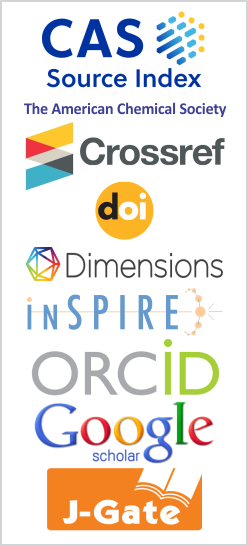Linearly Modulated OSL in K
DOI:
https://doi.org/10.26713/jamcnp.v9i1.1958Keywords:
LM-OSL, Photoionization cross-section, Detrapping probabilities, LiAbstract
K
Downloads
References
E. Bulur, A simple transformation for converting CW-OSL curves to LM-OSL curves, Radiation Measurements 32 (2000), 141 – 145, DOI: 10.1016/S1350-4487(99)00247-4.
E. Bulur, L. Bøtter-Jensen and A.S. Murray, LM-OSL signals from some insulators: An analysis of the dependency of the detrapping probability on stimulation light intensity, Radiation Measurements 33 (2001), 715 – 719, DOI: 10.1016/S1350-4487(01)00089-0.
D.J. Daniel, A. Raja, U. Madhusoodanan, O. Annalakshmi and P. Ramasamy, OSL studies of alkali fluoroperovskite single crystals for radiation dosimetry, Optical Materials 58 (2016), 497 – 503, DOI: 10.1016/j.optmat.2016.06.019.
S.J. Dhoble, S.V. Moharil and T.K. Gundu Rao, Correlated ESR, PL and TL studies on K3Na(SO4)2: Eu thermoluminescence dosimetry phosphor, Journal of Luminescence 93 (2001), 43 – 49, DOI: 10.1016/s0022-2313(01)00176-4.
M. Kumar, B. Dhabekar, S.N. Menon, M.P. Chougaonkar and Y.S. Mayya, LiMgPO4:Tb,B OSL phosphor - CW and LM OSL studies, Nuclear Instruments and Methods in Physics Research Section B: Beam Interactions with Materials and Atoms 269 (2011), 1849 – 1854, DOI: 10.1016/j.nimb.2011.05.010.
P.D. Sahare and M. Saran, Effect of pH on lyoluminescence of K3Na(SO4)2:Eu3+ phosphor for its application in dosimetry of high-energy radiations, Journal of Luminescence 179 (2016), 254 – 259, DOI: 10.1016/j.jlumin.2016.06.040.
P.D. Sahare and M. Saran, Particle size effects on the dosimetry characteristics of K3Na(SO4)2:Eu TLD micro- and nanophosphors, Journal of Luminescence 198 (2018), DOI: 10.1016/j.jlumin.2018.02.063.
A. Twardak, P. Bilski, Y. Zorenko, V. Gorbenko and O. Sidletskiy, OSL dosimetric properties of cerium doped lutetium orthosilicates, Radiation Measurements 71 (2014), 139 – 142, DOI: 10.1016/j.radmeas.2014.02.018.
V.H. Whitley and S.W.S. Mckeever, Linear modulation optically stimulated luminescence and thermoluminescence techniques in Al2O3:C, Radiation Protection Dosimetry 100 (2002), 61 – 66, DOI: 10.1093/oxfordjournals.rpd.a005936.
E.G. Yukihara and S.W. McKeever, Optically stimulated luminescence (OSL) dosimetry in medicine, Physics in Medicine & Biology 53 (2008), DOI: 10.1088/0031-9155/53/20/R01.
Downloads
Published
How to Cite
Issue
Section
License
Authors who publish with this journal agree to the following terms:- Authors retain copyright and grant the journal right of first publication with the work simultaneously licensed under a CCAL that allows others to share the work with an acknowledgement of the work's authorship and initial publication in this journal.
- Authors are able to enter into separate, additional contractual arrangements for the non-exclusive distribution of the journal's published version of the work (e.g., post it to an institutional repository or publish it in a book), with an acknowledgement of its initial publication in this journal.
- Authors are permitted and encouraged to post their work online (e.g., in institutional repositories or on their website) prior to and during the submission process, as it can lead to productive exchanges, as well as earlier and greater citation of published work.




